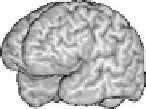Biomedical Engineering Reference
In-Depth Information
S(x)
T(x)
h(x)
g(x)
Figure 6.1:
Consistent image registration is based on the principle that the
mappings
h
from
T
to
S
and
g
from
S
to
T
define a point by point correspon-
dence between
T
and
S
that are consistent with each other. This consistency is
enforced mathematically by jointly estimating
h
and
g
while minimizing the in-
verse consistency error (
||
h
−
g
−
1
||+||
g
−
h
−
1
||
). The inverse consistency error
is minimized when
h
and
g
are inverse mappings of one another.
The forward transformation
h
from image
T
to
S
and the reverse transfor-
mation
g
from
S
to
T
are pictured in Fig. 6.1. Ideally, the transformations
h
and
g
should be uniquely determined and should be inverses of one another provided
the images only differ in shape and not structure. Estimating
h
and
g
indepen-
dently very rarely results in a consistent set of transformations due to a large
number of local minima. To overcome this deficiency in current registration sys-
tems, we jointly estimate
h
and
g
while minimizing the inverse consistency error
defined as
||
h
−
g
−
1
||
. Notice that the inverse consistency error is
minimized when the transformations
h
and
g
are inverse mappings of one an-
other. Jointly estimating the forward and reverse transformations provides addi-
tional correspondence information and helps ensure that these transformations
define a consistent correspondence between the images. Although uniqueness
is very difficult to achieve in medical image registration, the joint estimation
should lead to more consistent and biologically meaningful results since infor-
mation from one registration direction minimizes registration ambiguities in the
other direction.
Image registration algorithms use landmarks [1-4], contours [5-7], surfaces
[8-11], volumes [6, 12-21], or a combination of these features [22] to manually,
semi-automatically or automatically define correspondences between two im-
ages. The need to impose the invertibility consistency constraint depends on the
particular application and on the correspondence model used for registration. In
general, registration techniques that do not uniquely determine the correspon-
dence between image volumes should benefit from the consistency constraint.
||+||
g
−
h
−
1







